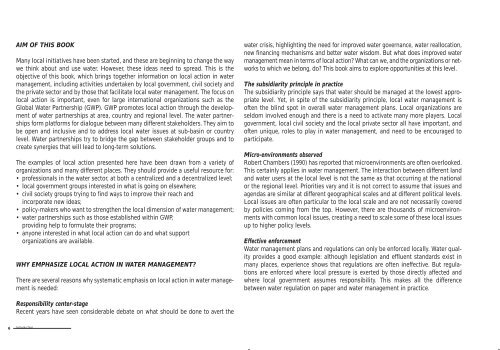Ideas for local action in water management Ideas for ... - MetaMeta
Ideas for local action in water management Ideas for ... - MetaMeta
Ideas for local action in water management Ideas for ... - MetaMeta
You also want an ePaper? Increase the reach of your titles
YUMPU automatically turns print PDFs into web optimized ePapers that Google loves.
6<br />
AIM OF THIS BOOK<br />
Many <strong>local</strong> <strong>in</strong>itiatives have been started, and these are beg<strong>in</strong>n<strong>in</strong>g to change the way<br />
we th<strong>in</strong>k about and use <strong>water</strong>. However, these ideas need to spread. This is the<br />
objective of this book, which br<strong>in</strong>gs together <strong>in</strong><strong>for</strong>mation on <strong>local</strong> <strong>action</strong> <strong>in</strong> <strong>water</strong><br />
<strong>management</strong>, <strong>in</strong>clud<strong>in</strong>g activities undertaken by <strong>local</strong> government, civil society and<br />
the private sector and by those that facilitate <strong>local</strong> <strong>water</strong> <strong>management</strong>. The focus on<br />
<strong>local</strong> <strong>action</strong> is important, even <strong>for</strong> large <strong>in</strong>ternational organizations such as the<br />
Global Water Partnership (GWP). GWP promotes <strong>local</strong> <strong>action</strong> through the development<br />
of <strong>water</strong> partnerships at area, country and regional level. The <strong>water</strong> partnerships<br />
<strong>for</strong>m plat<strong>for</strong>ms <strong>for</strong> dialogue between many different stakeholders. They aim to<br />
be open and <strong>in</strong>clusive and to address <strong>local</strong> <strong>water</strong> issues at sub-bas<strong>in</strong> or country<br />
level. Water partnerships try to bridge the gap between stakeholder groups and to<br />
create synergies that will lead to long-term solutions.<br />
The examples of <strong>local</strong> <strong>action</strong> presented here have been drawn from a variety of<br />
organizations and many different places. They should provide a useful resource <strong>for</strong>:<br />
•professionals <strong>in</strong> the <strong>water</strong> sector, at both a centralized and a decentralized level;<br />
• <strong>local</strong> government groups <strong>in</strong>terested <strong>in</strong> what is go<strong>in</strong>g on elsewhere;<br />
• civil society groups try<strong>in</strong>g to f<strong>in</strong>d ways to improve their reach and<br />
<strong>in</strong>corporate new ideas;<br />
• policy-makers who want to strengthen the <strong>local</strong> dimension of <strong>water</strong> <strong>management</strong>;<br />
• <strong>water</strong> partnerships such as those established with<strong>in</strong> GWP,<br />
provid<strong>in</strong>g help to <strong>for</strong>mulate their programs;<br />
• anyone <strong>in</strong>terested <strong>in</strong> what <strong>local</strong> <strong>action</strong> can do and what support<br />
organizations are available.<br />
WHY EMPHASIZE LOCAL ACTION IN WATER MANAGEMENT?<br />
There are several reasons why systematic emphasis on <strong>local</strong> <strong>action</strong> <strong>in</strong> <strong>water</strong> <strong>management</strong><br />
is needed:<br />
Responsibility center-stage<br />
Recent years have seen considerable debate on what should be done to avert the<br />
Introduction<br />
<strong>water</strong> crisis, highlight<strong>in</strong>g the need <strong>for</strong> improved <strong>water</strong> governance, <strong>water</strong> reallocation,<br />
new f<strong>in</strong>anc<strong>in</strong>g mechanisms and better <strong>water</strong> wisdom. But what does improved <strong>water</strong><br />
<strong>management</strong> mean <strong>in</strong> terms of <strong>local</strong> <strong>action</strong>? What can we, and the organizations or networks<br />
to which we belong, do? This book aims to explore opportunities at this level.<br />
The subsidiarity pr<strong>in</strong>ciple <strong>in</strong> practice<br />
The subsidiarity pr<strong>in</strong>ciple says that <strong>water</strong> should be managed at the lowest appropriate<br />
level. Yet, <strong>in</strong> spite of the subsidiarity pr<strong>in</strong>ciple, <strong>local</strong> <strong>water</strong> <strong>management</strong> is<br />
often the bl<strong>in</strong>d spot <strong>in</strong> overall <strong>water</strong> <strong>management</strong> plans. Local organizations are<br />
seldom <strong>in</strong>volved enough and there is a need to activate many more players. Local<br />
government, <strong>local</strong> civil society and the <strong>local</strong> private sector all have important, and<br />
often unique, roles to play <strong>in</strong> <strong>water</strong> <strong>management</strong>, and need to be encouraged to<br />
participate.<br />
Micro-environments observed<br />
Robert Chambers (1990) has reported that microenvironments are often overlooked.<br />
This certa<strong>in</strong>ly applies <strong>in</strong> <strong>water</strong> <strong>management</strong>. The <strong>in</strong>ter<strong>action</strong> between different land<br />
and <strong>water</strong> users at the <strong>local</strong> level is not the same as that occurr<strong>in</strong>g at the national<br />
or the regional level. Priorities vary and it is not correct to assume that issues and<br />
agendas are similar at different geographical scales and at different political levels.<br />
Local issues are often particular to the <strong>local</strong> scale and are not necessarily covered<br />
by policies com<strong>in</strong>g from the top. However, there are thousands of microenvironments<br />
with common <strong>local</strong> issues, creat<strong>in</strong>g a need to scale some of these <strong>local</strong> issues<br />
up to higher policy levels.<br />
Effective en<strong>for</strong>cement<br />
Water <strong>management</strong> plans and regulations can only be en<strong>for</strong>ced <strong>local</strong>ly. Water quality<br />
provides a good example: although legislation and effluent standards exist <strong>in</strong><br />
many places, experience shows that regulations are often <strong>in</strong>effective. But regulations<br />
are en<strong>for</strong>ced where <strong>local</strong> pressure is exerted by those directly affected and<br />
where <strong>local</strong> government assumes responsibility. This makes all the difference<br />
between <strong>water</strong> regulation on paper and <strong>water</strong> <strong>management</strong> <strong>in</strong> practice.



